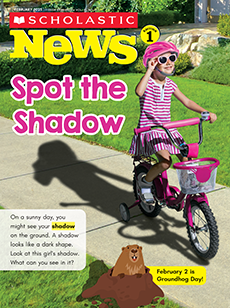A guide for using our resources
Children will learn about the life cycle of an apple.
Vocabulary: ripe, blossom, fruitlet, rotten
Science Focus: Plant life cycle
CCSS (and states that have similar standards): RL.1.1 key details; RI.1.5 text features; RF.1.1 ending punctuation; RF.1.2 long and short vowels; L.1.2 irregular words; SL.1.2 ask and answer questions
Simple, spectacular ideas to boost your lessons.
Paired Text Suggestion: The Apple Pie That Papa Baked by Lauren Thompson
Paired Text Suggestion: The Apple Pie That Papa Baked by Lauren Thompson
- This rhythmic tale is full of juicy adjectives, repetitive text, and a few wordless pages allowing for opportunities to fully explore the rich illustrations.
Punctuation Hunt: Question Marks
Punctuation Hunt: Question Marks
- Ask students to find all the question marks in the issue. Circle them! As a bonus, challenge students to find the one exclamation mark in the issue. Have students draw a star next to it.
Syllable Game: Bite the Apple
Syllable Game: Bite the Apple
- Students can practice segmenting words into syllables with this fun movement activity! Have students reach up high and pretend to pick a juicy apple from a tree. Tell them to listen to your words. When they hear a word with one syllable, they can take one crunchy “bite” from their apple. If they hear a two syllable word, they can have two crunchy bites! When a mistake is made, students can reach up and pick another apple to keep playing. Examples of words to say: apple, ripe, rotten, blossom, fruitlet, petals, green, red, mushy, fruit.
Hands-On Activity: Apples vs. Bananas
Hands-On Activity: Apples vs. Bananas
Skill: experimenting, observing
Materials: Apples vs. Bananas skill sheet, pencil, apple, banana, knife, plates, timer
- Observe fruits changing over time and check predictions with this experiment.
- Introduce the two fruits. Let students know you will cut a slice of each and watch them change over time. Which do they think will change first? Give students the Apples vs. Bananas skill sheet to record their prediction.
- Cut slices of apples and bananas. Provide each group or pair a plate with a slice of each fruit on it. Have students draw what the fruits looks like. Start a timer for 10 minutes. When the timer goes off, have students revisit their plate and skill sheet. Draw what the fruits looks like now.
- Set the timer for an hour and repeat the process. At the end of the experiment, have students circle the fruit that changed first. Was their prediction correct?
